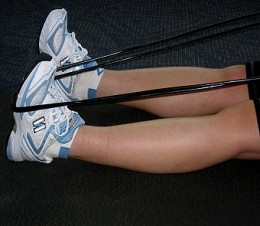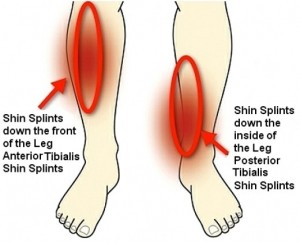Shin Splints
What are Shin Splints?
‘Shin splints’ or ‘shin splints’ is the common name for what is officially known as for medial tibial stress syndrome.
Pain commonly occurs anywhere along the shinbone from the knee to the ankle. The more common areas for pain are:
- on the inner side of the shinbone – ‘medial shin splints’
- on the outer side (front of the lower leg) – ‘anterior shin splints’
- on both sides of the shin bone in severe cases.
It is a common injury for a wide range of sports such as basketball, soccer and the various football codes. It is also a common running injury, particularly when running on roads and other hard surfaces.
 Surprisingly the exact cause of the pain is unknown and may vary among patients. It appears to be caused by strain or over stretching of the muscles and tendons that run along the length of the shin bone causing inflammation. Some recent research suggests it may be a stress reaction in the bone itself, or the muscle attachments to the bone.
Surprisingly the exact cause of the pain is unknown and may vary among patients. It appears to be caused by strain or over stretching of the muscles and tendons that run along the length of the shin bone causing inflammation. Some recent research suggests it may be a stress reaction in the bone itself, or the muscle attachments to the bone.
The injury appears to be a reaction to the stress of over-exertion or the pounding and jarring associated with many sports. It often occurs in runners which switch their brands of shoes but can occur in barefoot running as well.
Treatment For Shin Splints?
Like most sports injuries treatment includes the regular use of ice packs on the affected area, rest, anti-inflammatory medication such as aspirin and gentle stretching after a few days.
Unfortunately, once they occur it is more likely to happen again. It is worth while looking at what may have triggered the damage. Did you change the shoes you wear or your training routine? Many people find that switching training shoes and adding high quality cushioning insoles lowers the risk of developing shins splints. Increasing training distances slowly and training mostly on grass or other softer surfaces also help. Try to avoid jarring such as occurs when running down hills especially on asphalt. Most people recover within one or two months, without recurrences.
The pain of shin splints is usually mild and it pays to keep active by walking until the pain subsides. Always ramp up the length and intensity of your training slowly. If the pain is severe or prolonged you should see a doctor check for a stress fracture or other more serious injuries.
Stretches for Relief of Shin Splint Pain
A good basic exercise for relief is simple stretching
 Stretch 1
Stretch 1
Sit in a chair with your sore leg stretched out:
- Reach down to grab your toes
- Gently pull your toes and foot back toward your body.
- Keep stretching for 30-45 seconds
- repeat five or six times
- reverse the pressure while still holding your toes by gently pushing down for 30-45 seconds
- repeat the pushes five or six times.
- you can also use an exercise band or cord positioned around the ball of your foot
Stretch 2
- Sit on the floor with your feet pressed flat against a wall.
- Keep your heels on the ground and knees straight.
- With the palms of your hands flat against the floor, lean into the wall and stretch your calf and shin muscles.
Exercise 3
Calf raises help build strength in the muscles at the back of the lower leg, which help support the shin and prevent injuries.
- Stand on a flat floor with your feet about six inches (15 cm) apart.
- Shift your weight forward from your heels to the balls of your feet.
- Rise up on your toes and hold for 30-45 seconds
- Roll back and return your heels to the floor
- Repeat this exercise 10-15 times
Exercise 4
This exercise is designed to strengthen the tibialis anterior, which is the large muscle on the front lateral side of your shin that is often associated with shin splint injuries.
- Sit on the floor with your legs straight out in front, and toes pointing up.
- Move your toes toward your body, hold for 10-20 seconds and then slowly release.
- Repeat for 10 – 12 repetitions on each side
Advice On Choosing Athletic Sole Insert
Make sure you have a good quality athletic shoe designed for the type of activity that you undertake. Wearing shoes with poorly designed insoles that do not provide adequate cushioning can increase the risks of shin splints. The insoles wear-out and you should consider adding good quality replaceable insoles if you feel comfortable with them. Runners and walkers should replace their shoes regularly.
Stay off the Cement, Bitumen and other Hard Surfaces
Try to train on softer surfaces such as grass, running tracks and crushed gravel. Asphalt is more forgiving than concrete, but timber surfaces are also very hard unless they are suspended or cushioned. However, if you train on grass, be careful the avoid the trap of injuries caused by racing on roads without the right shoes or preparation. One way to reduce the risk of shin splints is to do cross-training. If you’re a runner, add some swimming, cycling, or other exercises that don’t put a strain on your shins. Running up and down hills, especially on roads and hard surfaces may increase the risk of shin splints.


